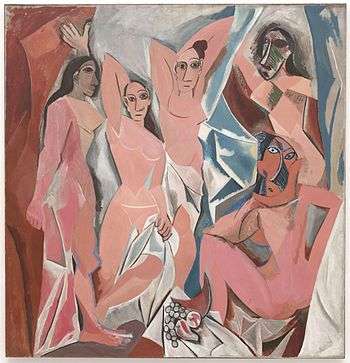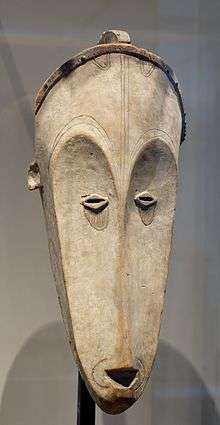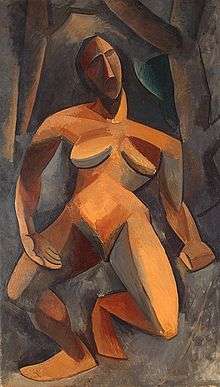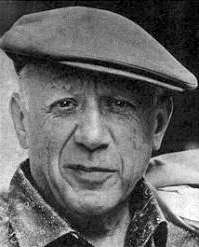Picasso's African Period

Picasso's African Period, which lasted from 1906 to 1909, was the period when Pablo Picasso painted in a style which was strongly influenced by African sculpture and particularly traditional African masks. This proto-Cubist period following Picasso's Blue Period and Rose Period has also been called the Negro Period,[1] or Black Period.[2]
Context and period

In the early 20th century, African artworks were being brought back to Paris museums in consequence of the expansion of the French empire into Sub-Saharan Africa. The press was abuzz with exaggerated stories of cannibalism and exotic tales about the African kingdom of Dahomey. The mistreatment of Africans in the Belgian Congo was exposed in Joseph Conrad's popular book Heart of Darkness. It was natural in this climate of African interest that Picasso would look towards African artworks as inspiration for some of his work; his interest was sparked by Henri Matisse who showed him a mask from the Dan people of Africa.[3]
In May or June 1907, Picasso experienced a "revelation" while viewing African art at the ethnographic museum at Palais du Trocadéro.[4] Picasso's discovery of African art influenced the style of his painting Les Demoiselles d'Avignon (begun in May 1907 and reworked in July of that year), especially in the treatment of the two figures on the right side of the composition.
Although Les Demoiselles is seen as a proto-cubist work, Picasso continued to develop a style derived from African art before beginning the analytic cubism phase of his painting in 1910. Other works of Picasso's African Period include the Bust of a Woman (1907, in the National Gallery, Prague); Mother and Child (Summer 1907, in the Musée Picasso, Paris); Nude with Raised Arms (1907, in the Thyssen-Bornemisza Museum, Madrid, Spain); and Three Women (Summer 1908, in the Hermitage Museum, St. Petersburg).
.jpg) Pablo Picasso, 1907, Nu aux bras levés (Nude)
Pablo Picasso, 1907, Nu aux bras levés (Nude)%2C_oil_on_canvas%2C_61.4_x_47.6_cm%2C_The_Museum_of_Modern_Art%2C_New_York.jpg) Pablo Picasso, 1907, Head of a Sleeping Woman (Study for Nude with Drapery), oil on canvas, 61.4 x 47.6 cm, The Museum of Modern Art, New York
Pablo Picasso, 1907, Head of a Sleeping Woman (Study for Nude with Drapery), oil on canvas, 61.4 x 47.6 cm, The Museum of Modern Art, New York Pablo Picasso, 1907-08, Vase of Flowers, oil on canvas, 92.1 x 73 cm, Museum of Modern Art, New York
Pablo Picasso, 1907-08, Vase of Flowers, oil on canvas, 92.1 x 73 cm, Museum of Modern Art, New York%2C_oil_on_canvas%2C_66_x_50.5_cm%2C_Hermitage_Museum%2C_Saint_Petersburg%2C_Russia.jpg) Pablo Picasso, 1908, Bols et flacons (Pitcher and Bowls), oil on canvas, 66 x 50.5 cm, Hermitage Museum, Saint Petersburg, Russia
Pablo Picasso, 1908, Bols et flacons (Pitcher and Bowls), oil on canvas, 66 x 50.5 cm, Hermitage Museum, Saint Petersburg, Russia Pablo Picasso, 1908, Dryad, oil on canvas, 185 x 108 cm, The State Hermitage Museum, St Petersburg
Pablo Picasso, 1908, Dryad, oil on canvas, 185 x 108 cm, The State Hermitage Museum, St Petersburg%2C_oil_on_canvas%2C_200_x_185_cm%2C_Hermitage_Museum%2C_Saint_Petersburg.jpg) Pablo Picasso, 1908, Trois femmes (Three Women), oil on canvas, 200 x 185 cm, Hermitage Museum, Saint Petersburg
Pablo Picasso, 1908, Trois femmes (Three Women), oil on canvas, 200 x 185 cm, Hermitage Museum, Saint Petersburg Pablo Picasso, 1908, Seated Woman (Meditation), oil on canvas, 150 x 99 cm, Hermitage Museum, Saint Petersburg
Pablo Picasso, 1908, Seated Woman (Meditation), oil on canvas, 150 x 99 cm, Hermitage Museum, Saint Petersburg%2C_oil_on_canvas%2C_60_x_73_cm%2C_Mus%C3%A9e_Picasso%2C_Paris.jpg) Pablo Picasso, 1908, Paysage aux deux figures (Landscape with Two Figures), oil on canvas, 60 x 73 cm, Musée Picasso, Paris
Pablo Picasso, 1908, Paysage aux deux figures (Landscape with Two Figures), oil on canvas, 60 x 73 cm, Musée Picasso, Paris Pablo Picasso, 1909, Nature morte à la brioche
Pablo Picasso, 1909, Nature morte à la brioche Pablo Picasso, 1909, Brick Factory at Tortosa (L'Usine, Horta de Ebro), oil on canvas, 50.7 x 60.2 cm, The State Hermitage Museum, Saint Petersburg
Pablo Picasso, 1909, Brick Factory at Tortosa (L'Usine, Horta de Ebro), oil on canvas, 50.7 x 60.2 cm, The State Hermitage Museum, Saint Petersburg%2C_oil_on_canvas%2C_65_x_81_cm%2C_private_collection.jpg) Pablo Picasso, 1909, Maisons à Horta (Houses on the Hill, Horta de Ebro), oil on canvas, 65 x 81 cm, private collection
Pablo Picasso, 1909, Maisons à Horta (Houses on the Hill, Horta de Ebro), oil on canvas, 65 x 81 cm, private collection.jpg) Pablo Picasso, 1909, Harlequin (L'Arlequin)
Pablo Picasso, 1909, Harlequin (L'Arlequin) Pablo Picasso, 1909, Buste de femme (Femme en vert, Femme assise), oil on canvas, 100.3 x 81.3 cm, Van Abbemuseum, Netherlands. This painting from the collection of Wilhelm Uhde was confiscated by the French state and sold at the Hôtel Drouot in 1921
Pablo Picasso, 1909, Buste de femme (Femme en vert, Femme assise), oil on canvas, 100.3 x 81.3 cm, Van Abbemuseum, Netherlands. This painting from the collection of Wilhelm Uhde was confiscated by the French state and sold at the Hôtel Drouot in 1921%2C_oil_on_canvas%2C_60.3_x_51.1_cm%2C_The_Art_Institute_of_Chicago.jpg) Pablo Picasso, 1909, Head of a Woman (Tête de femme), oil on canvas, 60.3 x 51.1 cm, The Art Institute of Chicago
Pablo Picasso, 1909, Head of a Woman (Tête de femme), oil on canvas, 60.3 x 51.1 cm, The Art Institute of Chicago
See also
Notes
- ↑ Howells 2003, p. 66.
- ↑ Christopher Green, 2009, Cubism, MoMA, Grove Art Online, Oxford University Press
- ↑ Matisse may have purchased this piece from Emile Heymenn's shop of non-western artworks in Paris, see PabloPicasso.org.
- ↑ Picasso, Rubin, and Fluegel 1980, p. 87.
References
- Barr, Alfred, H, Jr. Picasso: Fifty Years of His Art (1946)
- Richardson John. A Life of Picasso. The Prodigy, 1881-1906. New York: Alfred A. Knopf, 1991. ISBN 978-0-307-26666-8
- Richardson, John. A Life of Picasso, The Cubist Rebel 1907-1916. New York: Alfred A. Knopf, 1991. ISBN 978-0-307-26665-1
- Picasso, P., Rubin, W. S., & Fluegel, J. Pablo Picasso, a retrospective. New York: Museum of Modern Art, 1980. ISBN 0-87070-528-8
- Rubin, W. S. "Primitivism" in 20th Century Art: Affinity of the Tribal and the Modern. New York: Museum of Modern Art, 1984. ISBN 0-87070-534-2
- Howells, R. Visual Culture. Wiley-Blackwell, 2003. ISBN 0-7456-2412-X
